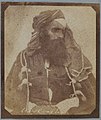File:Photograph of Dewan Mulraj in 1849 after capture by the British.jpg

File originale (808 × 960 pixel, dimensione del file: 195 KB, tipo MIME: image/jpeg)
| Questo file e la sua pagina di descrizione (discussione · modifica) si trovano su Wikimedia Commons (?) |
Dettagli
| DescrizionePhotograph of Dewan Mulraj in 1849 after capture by the British.jpg |
English: Photograph of Dewan Mulraj (alternatively spelt as Mool Raj or Mul Raj with a space) in 1849 after capture by the British. He was the Diwan (governor) of Multan. He was captured by British forces during the Second Anglo-Sikh War. Photo from the National Army Museum, it was originally taken by John McCosh in 1849 while Mul Raj was imprisoned.
Correction to image title: the photograph was taken in early 1848 rather than in 1849 but it was first published in 1849. Further information (taken from: [1], [2]): "The first ever daguerreotype – photo – portrait of a Sikh or Punjabi was taken in Lahore in early 1848 by Dr John McCosh, a surgeon in the army of the British East India Company. The subject was Diwan Mool Raj, the Sikh Governor of Multan, taken captive and condemned to death by the British. He was the last flicker and certainly an unsung hero of the sovereign Sikh state of the Punjab. He, along with Bhai Maharaj Singh, had led the stiff resistance against the British army at the battle of Multan." ... "The definition of the word portrait as an artistic representation of a prisoner taken by an invading army cannot be strictly applied, especially to the one of Diwan Mool Raj. The McCosh collection in the National Army Museum in London, England, consists of 310 surviving photographs of British officers and their families." ... "The Diwan portrait was first published in the Illustrated London News (1 September, 1849) with the following caption: ('The First Photo Portraiture of Sikhs & Punjabis', SikhChic, Amarjit Singh Chandan, 2012) This photograph may have originally been arranged on a page grouped together with other photographs labelled "Sikhs", with each having an album/mount caption, as per Elizabeth Edwards and Ella Ravilious in 'What Photographs Do: The Making and Remaking of Museum Cultures' (pages 142–143, 21 November 2022, ISBN: 9781800082984), available for free download via: [3] Quote from the above discussing this:
|
| Data |
inizio del 1848 date QS:P,+1848-00-00T00:00:00Z/9,P4241,Q40719727 |
| Fonte |
1) https://tariqluqmanview.blogspot.com/2018/12/25-historical-images-from-multan-history.html 2) https://twitter.com/indiahistorypic/status/951107807494877190 3) https://maddyworks.com/john-mccosh/ 4) https://www.sikhchic.com/article-detail.php?id=3645&cat=1 |
| Autore | John McCosh |
Licenza
Questo file è nel pubblico dominio in quanto mera operazione meccanica di scansione o fotocopia di un file originale nel pubblico dominio, oppure - con palese evidenza - è così simile ad una scansione o fotocopia che non ci si aspetta sia possibile la protezione del copyright. L'originale è nel pubblico dominio per la seguente ragione:
Questo tag è specifico per essere applicato in quei casi in cui vi è la necessità di affermare che qualsiasi modifica (ead esempio luminosità, contrasto, colour-matching, sharpening) è di per se stessa mancante di creatività in modo tale da non generare un nuovo copyright. Può essere usato dove non si sa se sia stata fatta qualche modifica, oppure quando le modifiche sono evidenti ma insufficienti per generare un nuovo copyright. Se si è certi che non ci siano state modifiche, è più appropriato usare {{PD-old}}. Vedi Commons:When to use the PD-scan tag. | |||||
Didascalie
Elementi ritratti in questo file
raffigura
image/jpeg
Cronologia del file
Fare clic su un gruppo data/ora per vedere il file come si presentava nel momento indicato.
| Data/Ora | Miniatura | Dimensioni | Utente | Commento | |
|---|---|---|---|---|---|
| attuale | 21:00, 9 dic 2022 |  | 808 × 960 (195 KB) | MaplesyrupSushi | Uploaded a work by John McCosh from 1) https://tariqluqmanview.blogspot.com/2018/12/25-historical-images-from-multan-history.html 2) https://twitter.com/indiahistorypic/status/951107807494877190 3) https://maddyworks.com/john-mccosh/ with UploadWizard |
Pagine che usano questo file
La seguente pagina usa questo file:
Utilizzo globale del file
Anche i seguenti wiki usano questo file:
- Usato nelle seguenti pagine di en.wikipedia.org:
Metadati
Questo file contiene informazioni aggiuntive, probabilmente aggiunte dalla fotocamera o dallo scanner usati per crearlo o digitalizzarlo. Se il file è stato modificato, alcuni dettagli potrebbero non corrispondere alla realtà.
| Software | |
|---|---|
| Rapporto di campionamento Y / C |
|
| Versione del formato Exif | 2.2 |

